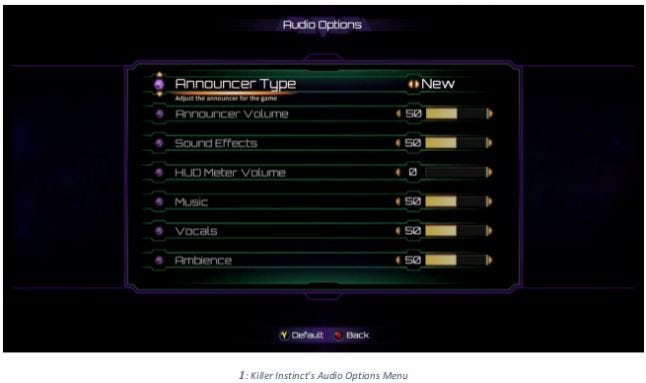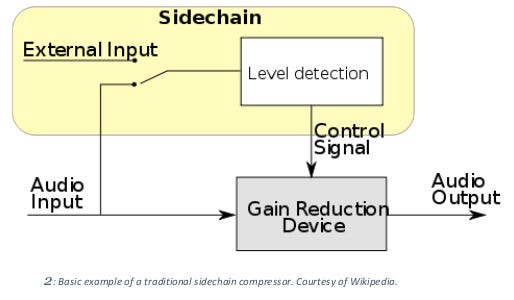Zack Quarles is an audio director and supervising sound designer at Microsoft Studios.
One of the main audio goals for our fighting game reboot Killer Instinct (KI) was player feedback. We wanted to make sure that someone knew exactly what was going on at any given time using audio alone.
In fact, one of the main directives I gave from a sound design standpoint was to make sure each character/game mode was identifiable enough that someone would be able to tell what was going on even if they weren’t in the same room that the game was being played in. This came down to iconic sound design and a clean mix.
Our top priorities were to make sure that a player understood when they were:
Giving Damage
Receiving Damage
Blocking Damage
These became the primary filters that everything else poured through. They became the lens through which we approached all things audio. These priorities shone a light on something far more important and totally unexpected: accessibility through audio for people with low to zero vision acuity.
Killer Instinct is classified as a part of the “Games as a Service” model. This means that after the initial development/release; the game continues to live and grow. There were multiple rolling updates that would introduce new characters, stages, game modes, address balance issues, fix bugs, and incorporate community feedback.
These updates were rolled into “seasons”. As of this writing, KI has had three seasons each consisting of at least eight new characters and multiple games modes along with an extension of three additional characters after Season 3 wrapped.
.jpg/?width=646&auto=webp&quality=80&disable=upscale)
Over the course of development, I became increasingly involved with accessibility for mainstream gamers without sight. A gamer by the name of SightlessKombat reached out to me with some feedback and requests to help KI become more accessible over the course of its development lifetime.
He and I would often chat via social media circles and I would either implement the changes/requests as it was appropriate or take his feedback to the team to see what we could do.
Between the initial audio pillars and directives that were established with Killer Instinct at the very beginning of the project, the continued growth as it matured in “the wild”, and the work that SightlessKombat and I have done, KI is a much more accessible game than many out there.
Is it perfect? Absolutely not. There is plenty of room to grow, but I do believe that it has become a great springboard for discussions on “best practices” that game teams should keep in mind when thinking about low to zero vision accessibility in their games.
Over the course of Killer Instinct’s development there are many things that we did that worked well. There are a few others that didn’t quite hit the mark due to a brutal schedule and a lean pool of resources. At the end of it all; I came away with several ideas that I think are important to consider beyond just the Killer Instinct franchise to improve game accessibility at large.
.jpg/?width=646&auto=webp&quality=80&disable=upscale)
Things that worked well
1) Audio Mix – The game went through several incremental mixes after each release and then a major “remix” at the end of each season to make sure everything was working well with each other. The initial mix of Season 1 happened right before launch which is when we really established the idea of Giving/Receiving/Blocking Damage as the primary feedback filter.
As the game matured, we continued to nuance the mix. We started to prune certain aesthetic details back in favor of stronger player feedback and a more focused mix. We also started to zero-in on player movement as a point of focus to allow gamers without sight to tell where they were in the battle arena while they were in combat.
So, footsteps, jumps, jump lands, foley movements, etc. were all brought up in the mix. Ambient loops and sweetener layers that didn’t provide strong player feedback were backed off a bit. This still allowed for a very layered soundscape for the game but we really wanted to focus on the individual characters to make sure that the player could tell where they were and what they were doing at any given time. Everything else was gravy.
2) Audio Panning – We split the screen into three major sections during gameplay: Left, Center, and Right. When a player passes through one of these sections we do an aggressive hard pan on their location to make sure that the player can track where they are in the battle arena at any given time from audio alone.
This might seem drastic when you first start playing the game, but once you sit down and hear it in action, it starts to feel natural. Particularly over headphones. Likewise, when we are in the character selection screen, we hard pan Player 1 UI sounds in the left channel and hard pan Player 2 UI sounds in the right. It gives a very clean and distinct method of letting the player know who is selecting what.
3) Volume Sliders with Optional Gameplay Content – We allowed the player a lot of freedom to customize their aural experience with Killer Instinct. It is common practice to provide volume options to turn music up and down in concert with SFX and Voice Over.
We also allowed the player to adjust volume on ambient sounds, announcer voice, change their announcer style, and provided a slider for very specific accessibility content for gamers without sight. It’s turned off by default, but gives the option to players to leverage this specific content. More details on that particular feature later.

4) Iconic/Identifiable Content – One of the best ways to make a game accessible to low/zero vision players is having strong content that people recognize at a moment’s notice. One of the primary audio pillars for Killer Instinct was to make sure that people could tell which characters were fighting each other even if they were not in the same room. Jago sounds radically different than Cinder who sounds radically different than Rash the Battletoad, and so on.
This means that there is a LOT of content in KI. Each character averages around 1,000 bespoke sound effects. In addition to character audio, there are tons of HUD audio cues that reinforce what is happening during a match. Player 1 gains a shadow point? Very specific sound cue plays hard-panned to the left. You know exactly what you have gained and when.
5) Sidechain Compression – Killer Instinct is not a subtle game and there is a lot going on at any given time. You have two characters duking it out, a pulse-pounding soundtrack rocking, and an announcer screaming at the top of their lungs. Everything is full-spectrum and everything is dialed to 11. You need to find clever methods of carving out headroom to allow the important stuff to pop and the less important content to duck away when it’s not imperative.
KI uses AudioKinetic’s popular audio middleware; Wwise. Today, Wwise has a feature called High Dynamic Range Audio (HDR…more on that later) but this feature was not available when KI first released, so we needed to figure out a way using what was available to us to get a similar result. Enter Sidechain Compression. Sidechain Compression has two inputs: one is the signal to be processed while the other is to control the compression.
Now, to put it in game terms, we needed to build a bus hierarchy that would track multiple game states and duck certain busses based off what was happening in the game. For example, if someone gets punched, we want to duck the music slightly for the duration of that punch, so it will pop out of the mix and have more of an impact (so to speak), and therefore, be heard more clearly.

The issue with this method is that it takes a LOT of work to get setup manually. Mr. Jean-Edouard Miclot of Double-Helix (Audio Lead/Senior Sound Designer for Killer Instinct: Season 1) did a lot of research and experimentation to put this together.
I believe we counted that Killer Instinct has somewhere around 112 busses/sub-busses. Here’s a snapshot of just a little bit of the schematic of the bus hierarchy/structure (see image 4):
6) Announcer – The Killer Instinct legacy has always included the over the top announcer screaming at you at the top of its lungs. In fact, this was one method that the original creators got arcade people to perk up their ears and check out the game.
You’d hear this massive, “ULTRAAAA COMBOOOOOO” bellowing from the back of an arcade and it would pique your interest. This was something that we needed to carry over from the original game. It serves a couple of purposes:
It provides a fun personality and identity to the game that no other fighting game has. You know exactly what game you are playing the minute you fire it up.
It provides valuable feedback to the player during a match and keeps you updated on how you, or your opponent, is doing. It will give you information about when you have successfully done a combo, what strength of combo you achieved, if you are getting close to death, if you’ve done something spectacular in the match, etc. it is the Voice of God narrating your battle.
7) Dynamic Music – Music that changes with the action in a game can be very beneficial to help the player understand how they are doing within a game experience. With Killer Instinct, we do a significant amount of data tracking within a match and hook that data into several different music states.
Each character has a suite of music “sections” that consist of several loops of music which are typically 4-8 bars in length that the system will stitch together and play back based off of what state the match is in. These states transition from one another by completing which measure they currently are in and land on the downbeat of the next state.
This creates a seamless and totally dynamic experience with every match. A typical match flow consists of the following states:
Character 1 Intro – The opening cinematic of the first player entering the stage. This transitions to Character 2 Intro (even if the player skips the cinematic).
No tags.





































